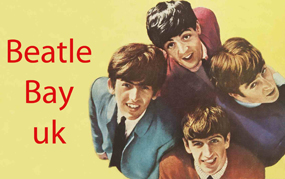
Please Please Me
Side 1
Complete Stereo Run (1963-2025)
Side 2

Please Please Me Complete Mono Run HERE
This is the Very first showing of the Stereo playing surface which would go on to be pressed on all 60's and early 70's Pressings. This has the Matrix number of YEX 95-1 coupled with the fabled earliest 1 G mother which the Gold Stereos have below. These were EMI in-house and weren't available to the public. This was featured in the Record Collector Magazine Oct 23 (No.549) issue under "Most Wanted".


The flip side of these test "White Label - Not For Sale" - pieces of vinyl have a test tone that plays continually and has a matrix denomination of LPFB 2 pressed on the vinyl on the dead wax / run off.
Needless to say these are priceless with this being the only known copy of the STEREO side 2 Record.
I am still looking (been looking for years) for the side 1 (YEX 94-1) counterpart, anyone?..
The Please Please Me Long Player entered the charts on 6th April 1963 at number 8. The next week it took the No.3 spot and again the following week. On the 18th April 1964 it was still at No.3 and in between in that full year it was pretty much either No.1 (30 straight weeks in a row), or at the No.2 spot and that's only because "With the beatles" LP came out in late Nov 63 and took over the 1 spot almost immediately. What that meant was lots of pressing runs with lots of different labels and their variations.
The infamous 1st Press Gold STEREO Parlophone Label. Released almost as an after thought 6 weeks after the original release date, & possibly waiting for the first of the pressing machines pressing the mono to free up. The very first run of this stereo pressing had this gold printed label, and considered by most as the ultimate (& Expensive) Beatle collectable as fewer than 2000 were ever pressed, and less than half have ever turned up..


Collectors are well aware of the stamper codes which can be found on the run offs on the vinyl. Stampers are 1G/1R (side 1/side 2), 1R/1G and 1A/1R. The 1G/1R is from pressing machine 1, 1R/1G (machine 2), and 1A /1R(machine 1) the rarest of the 3 by far, as was pressed after the Northern Songs edition below. Considering only 2 or 3 copies have ever surfaced, possibly the Hayes pressing plant just used the labels that were lying around.
2nd Press Gold Parlophone Label.
The publishing Credits for "I Saw Her Standing There, Misery, Do you want to know a secret, and There's a Place" are now credited to "Northern Songs Ltd", the brand new company formed to deal with the Lennon-McCartney writing partnership.


These "Northern Songs" Gold records are a lot rarer than the Dick James label by almost 5 to 1 as they almost immediately changed to the Yellow & Black 3rd Press below.
Seen with 1G/1R and 1R/1G mother stampers only as so far, no 1A/1R presses have come to light..
3rd Press.
1st Yellow & Black Parlophone Label.
This has the additional very small 33 1/3 which was left over from the gold labels (near the centre hole).
With this Stereo edition being far rarer than it's MONO little brother.


These elusive labels are even rarer than the "Northern Songs" Golds, and for many years went un-noticed till very recently.
Stampers used were 1M/1G & 1P/1G from pressing machine 2, and as of yet, no 1O/1G has ever surfaced with this label.. BUT one has just recently surfaced oddly on a 5th Press Type 1!
4th Press - type 1.
This was considered the 3rd press for many years (and still is by many collectors) until the discovery of the above label, and was only around for a brief moment in 1963 before it changed again.
This is near identical to the 3rd label except there is no little 33 1/3. Mother & Stampers being 1P / 1G on one machine, and 1GD / 1P on the second machine..
4th Press - type 2.
This slight variation of the text layout here shows there was another run of this with only a few hundred or so pressed of type 2 which is much rarer with these correct side 1 & 2 labels rather than a crossover of the side 1 label here and the side 2 label above which is common with this release.
This type 2 straight copy is only found on a 1GD / 1P configuration
5th Press - type 1.
Again, because of the inclusion of the 3rd label, this is / was usually known as the 4th Label. There are in fact 2 types, this was the first, with the appearance of "Recording First Pub.1963", indented to the (YEX.94), though at the same position to the 1 (&2) as the mono counterpart. The general text was also completely changed to what would become the standard Track overlay.
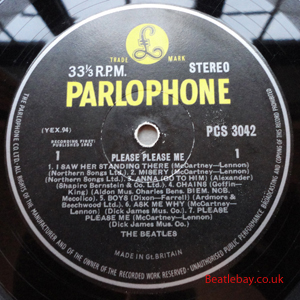
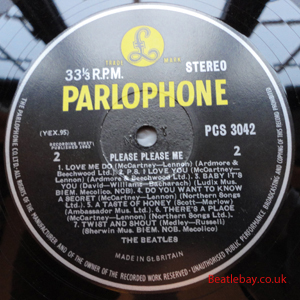
These labels are just as rare as the 4th press above, as was almost immediately pressed straight after, starting with the same mother stampers 1GD/1P & 1P/1G. The only other stamper configurations I've seen with this label are the very early unheard of 1G/1A, the missing 1O/1G from the 3rd press, and a 1O/1R, all being very rare with only singular copies I have of each seen. One could argue that this is also a 3rd press with those Stampers as 1G/1A is straight after the golds!
5th Press - type 2a.
Very nearly the same label as type 1 above except the (YEX.94) and the "Rec.First Pub. 1963" have been centred to the 1 & 2 on both sides of the label.
There are a couple of slightly reshuffled lines though, noticeably the 7th line (Beechwood etc) on side 1 starts a fraction before the M in MECOLICO on line 6..


And the last line on side 2 (Sherwin etc) is longer and starts just before the T in "Twist" above it.
This was the transitional press to type 2b, and seems to be for two runs only with stampers being 1H/1A and 1H/1P. Incidentally, the 1M stamper used on side 2 was coupled with 1GO on side 1 and is the earliest known type 2b label below and was probably pressed on Machine 1..
5th Press - type 2b.
Nearly exactly the same as type 2a above, except the third line on side 1 is now slightly longer.. This will now stay the standard typeset for a couple of years till the 6th type 4 press. This is by far the most common early Stereo edition, though still rare in comparison to the early Mono's.


This was still being pressed with the introduction of the 2c label below and were being pressed simultaneously towards the end of this run. You can tell this as the stampers no. codes are intermingled with each other from the later runs of this type. This was also exactly true with the mono counterpart of this and the label below.
5th Press - type 2c.
This label was right on the cusp before the change to the 6th press label below. Again, nearly identical to the type 2b above, it is actually or seems to be a re-use of the 5th press type 1, but with the Rec. First Pub centred as per the 2 above labels.
On side 1, you can see MECOLICO and BEECHWOOD lined up, and the 3rd line (Northern Songs etc) shortened again.
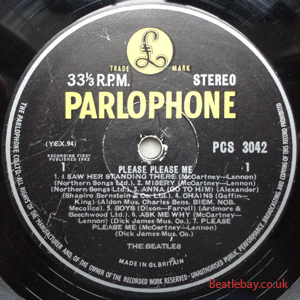
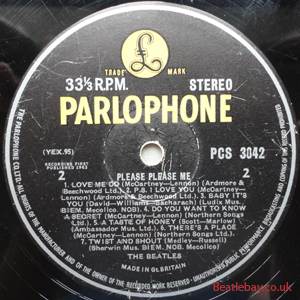
On side 2, the 5th line (BIEM etc) has been shrunken slightly and the last line (Sherwin etc), now back neatly under Twist and Shout . These pressings came in the first Garrod & Lofthouse Large Stereo Covers just before the Mid-size Stereo Covers.
Stampers start around the 1GL/1GR (18th & 12th) mark.
Because these are VERY slight changes, these have been overlooked until now.
6th Press - type 1a.
This label introduced the new "Sold In the UK, Subject to Resale" Line across the label.
The Side 1 picture used here was a cross over (with side 2 being a 5th type 2) thus being the very first 6th press side 1.. stamper number being.. 1RD/1GH (20th & 17th).


The side 2 picture used here is also a transitional copy with a 5th T2 on side 1! (opposite of side 1).., so this also tells me it was the very first showing of the "Sold in the UK text" on side 2.
Incidentally, the stamper number for this side 2 is... 1 GT/1 GP (19th & 16th).
6th Press - type 1b.
The label is exactly the same as the type 1a above except this has the little dot missing on side 1 between the number "2" and the song title "Misery".
I have two of these now so can confirm it is actually an omission rather than just a printing press mistake.
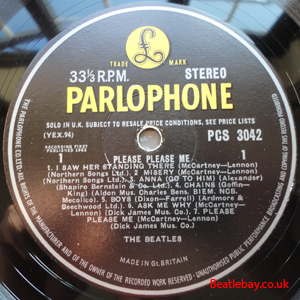
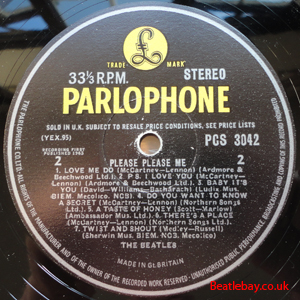
The Stampers for this edition was the first showing of 1 RD/ 1GH (20th & 17th). Whether this was pressed simultaneously on Machine 2, I have yet to determine..
This also came with the midsize stereo cover
6th Press - type 2a.
Same typeset for side 1 as the two labels above, but the change here is the Side 2 track listing which has been slightly reshuffled, the 6th line being the easiest way to spot this. .


This is the standard and most seen 6th press (or the one everybody knows about).
I have 3 of these and all Stampers are 1 RD/1 GH (20th & 17th)
6th Press - type 2b.
So far as I can tell, this is exactly the same as type 2a above, except the 4th line on SIDE 2, there is a DOT missing after (Ludix Mus , and a DOT missing between the "5" and "A TASTE OF HONEY".


This happened either just after the above label or at the same time as I have two of these , stampers being 1 RD/1 GH (same as above) and the second copy being 1RR/1GT (22nd & 19th)..
Ideally looking for a RG/GL (21st & 18th) pressing to know for sure :) Anyone?
6th Press - type 3. This label introduced a new font to the same layout as before and was only around for a very short time, perhaps being pressed on one run only.
This was my nemesis for a while, as (was) my next to next to last to track down, putting paid to rumours that this label press didn't exist..
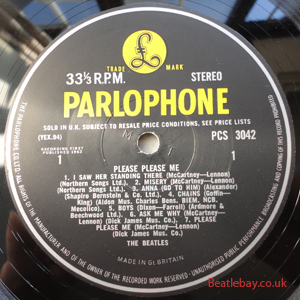
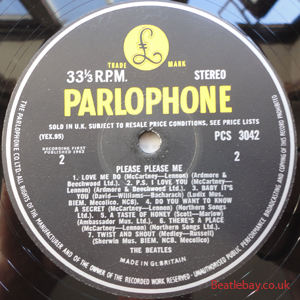
These 6th Presses mostly came with the rare mid-sized Stereo Cover.
A rare combination indeed!
6th Press - type 4. This label has the same new font, but the track layout changed in order to read better.
This still had the "The Parlophone Co Ltd." around the rim instead of the new "The Gramophone Co Ltd".
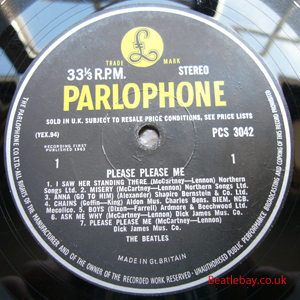
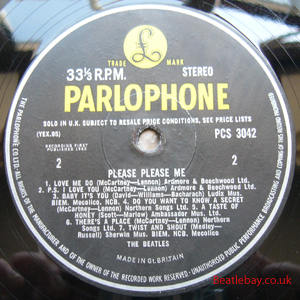
This then was the last of the Stereo labels to have "The Parlophone Co Ltd etc" around the edge of the label with the "Sold in the UK" statement.
These 6th Presses were also unique having no Mono counterparts (probably due to over pressings of the mono still in stock). .
Stampers are 1 RL / 1 RA for this edition.
7th Press - type 1. Near identical to the above label except it now reads "The Gramophone Co Ltd" around the edge, and "Rec.First Pub.1963" is now "(P)1963", as in keeping with the Mono pressings.
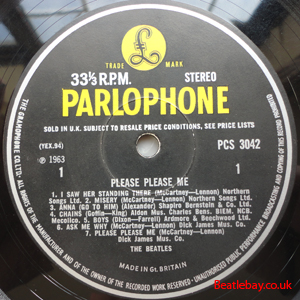
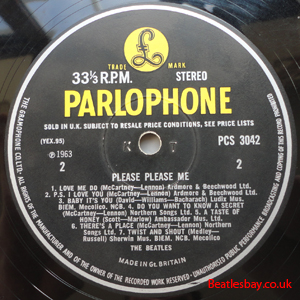
TRACK spacing on side 1, same as above with the "7" starting below the "E" in Ask ME Why.
Side 2 is just very slightly different also.
Very rare to see this label as have been looking for it for many years.
Stampers are 1 RP / 1 RP
7th Press - type 2.
This is near identical to the new type 1, but has the "7" on side 1 starting under the "M" in Ask Me Why and not the "E".
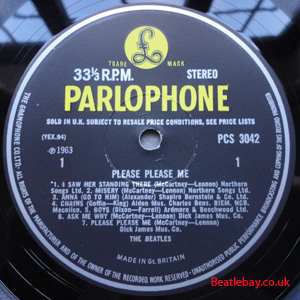
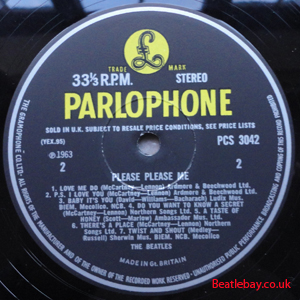
7th Press - type 3.
This was for many years the first label to have the Gramophone Co Ltd around the edge of the label, that was until the 2 above labels came to light!.
Looks the same as type 2 above but..
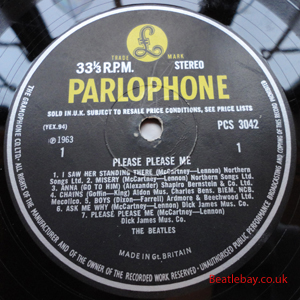
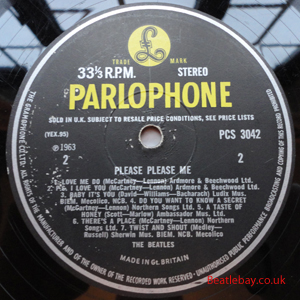
This has the elusive extra DOT (or period mark) on the "Sold in the .U.K. subject to resale etc" statement on side 1 (as per the Mono's at this stage too). This was an oversight on the typeset on the second pressing machine and can be seen on lots of EMI Artists pressings of the time as well as some of the other Beatle releases.
Stampers are 1 RO / 1 RL
7th Press - type 4.
This is the next incarnation with the "(YEX.94)" placed on top of the "(P)1963", though not yet in line with one another.
Gone is the Dot again, so please be on lookout for one WITH the Dot.., thou it's very unlikely one will pop up as I think the DOT was unique to the second printing press make up.


7th Press - type 5.
Another one that has just come to light and at first glance is exactly the same as the above label. The difference is the rather small 33 1/3 which was a mistake and was probably left over from being used pressing the newer "A Hard Day's night" LP just moments before..
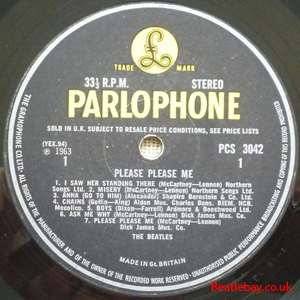
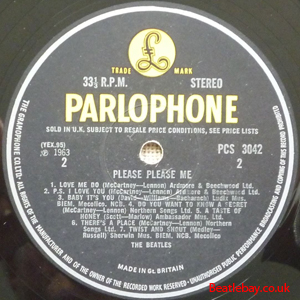
Small little 33 1/3 on side 2 also.
The stamper number was one more on from type 4. This could of course mean they were being printed at the same time on different machines. Very rare to see this label and not known about til now.
7th Press - type 6.
This next run saw the "(YEX.94)" & "(P)1963" more in line with one another, and will stay that way from now on.
Another new one that's just popped up, it seems every pressing run was different, which is great (or bad) for collectors!.


7th Press - type 7.
The Dot's back, and on first glance that seems to be all the difference between this and the above label. Though minute examination reveals the 3rd line on side one is just marginally shorter, which proves the theory of 2 pressing machines running simultaneously for each period or EMI order!
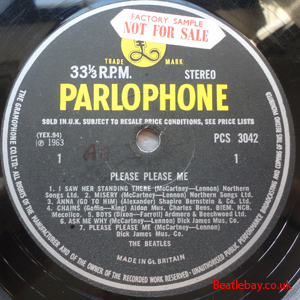

Side 2 seems to be identical to the above label.
7th Press - type 8.
Mother Stampers for this one are 1 AR / 1RT and fall neatly after the type 6, a little above, which is correct as was pressed on machine 1. No Dot (or Period mark some people like to call them). Curiously, the E in Lennon on side 1 is half missing in all copies of this press, so is an easy way to identify the type 8.
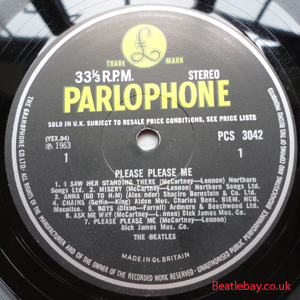
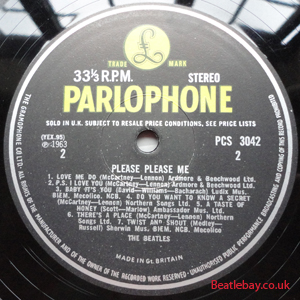
The main feature to look out for is the 5th line on side 1 being completely stretched past to where it was originally a few pressings ago, and the second line on side 2 being shrunken just slightly to the 2 above labels, before being finally changed to standard text setting starting with type 8 below.
7th Press - type 9.
Another slight reshuffle of the text sees the 1st line on side 1 pulled more to the left and the 5th line reduced. The side 2 being back to more in line with the 7th press type's 1, 2 and 3, a little above.
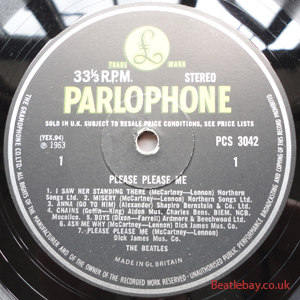
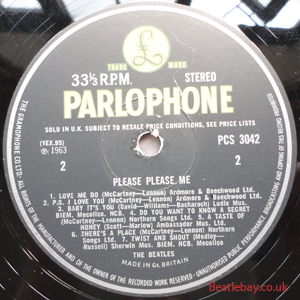
Side 2 will now stay basically the same until the 9th press one box EMI labels.
7th Press - type 10.
Seems to be exactly the same as the type 9 label(s) above but printed on a different textured label. Only this example has turned up so far so eyes down on look out for another..
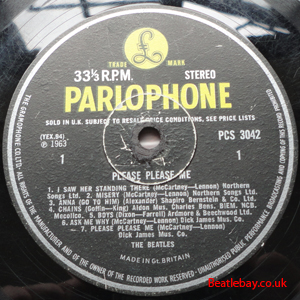
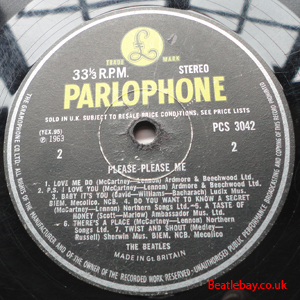
7th Press - type 11.
A new squared look for side 1, lines 5 & 6 pulled right to the left.
I would think a passage of time had elapsed before EMI needed to print or press these stereo PPM's.
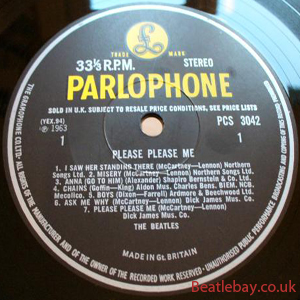
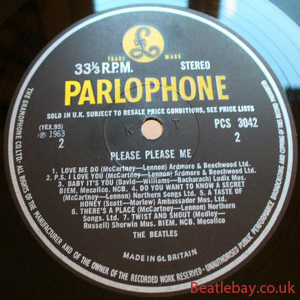
These seemed to be released on one run only before it changed to the next label below.
7th Press - type 12.
Same as above, though this has an extra Dot in the "Sold in the .U.K. statement" on side 1. This was common across all EMI releases at the time.


Same side 2 as above.
This was possibly pressed on machine 2 at the same time as the above press (which was pressed on machine 1 perhaps).
7th Press - type 13.
This edition being defined by a spelling mistake on side 2 where it says (YEA.95) and not (YEX.95).
This has just come to light and I wonder why no one has spotted this before!!!!!
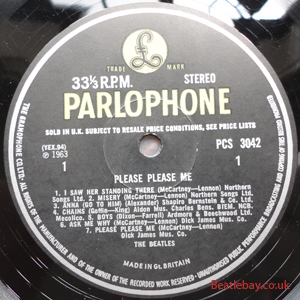
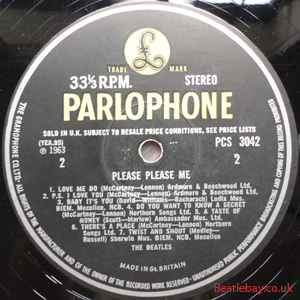
7th Press - type 14.
The Dot was back again when this run was pressed and the spacing of the letters and titles are EXACTLY the same as the above label thou the YEA is now YEX on side 2.
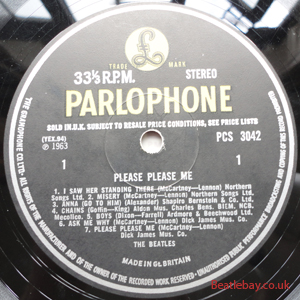
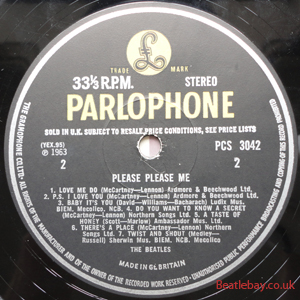
7th Press - type 15.
Again, because of the stampers, this was definitely pressed later than type 13 or 14, and only for one run as the stampers were one more on again too!.
.


7th Press. - type 16.. (thou could be argued to be an 8th press type 2 as could be from pressing machine 2).
A very strange and rare one indeed. This one bridges the gap to the 1969 8th press. My only copy has the extra Dot again.. Perhaps there is a version without? Anyone?


The last of the "Sold in the UK" yellow and black Parlophone.
This has the same mother stamper codes as the 8th press below..
8th Press - type 1. No "Sold in the U.K. " statement is the first thing that sets this apart, though the layout and label paper consistency is in keeping with the above label. .
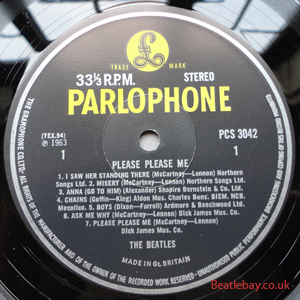

8th Press - type 2.
Looks the same as type 1 except the text being more tightly spaced with "The Beatles" font being the same smaller size as some of the 7th presses.
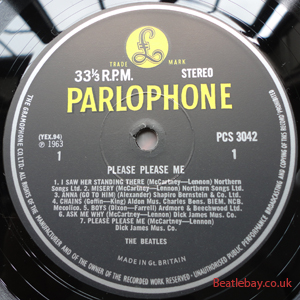
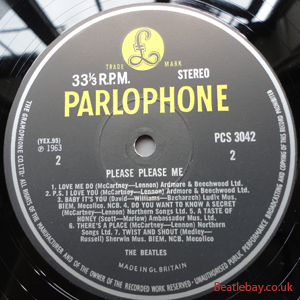
No "Sold in the U.K. " statement also. With the last set of stampers for this edition being 2MM / 1MD, this may have been the last yellow / black Stereo Label.
9th Press - type 1a.
This starts with 2 MA / 1MA as the mother stampers numbers (til we find any earlier to be sure), this was the first showing of the new updated Black and Silver Parlophone label.


These 9th press labels are defined by having a single EMI within a small Box on each side of the labels.
Interestingly, this label also had one of the last or the last run of One EMI pressings with stampers being 2PM (or PH) / 1PG which implies all these one box emi labels were all pressed around the same time period of a month or two.

9th Press - type 1b.
This one starts with 2 MP / 1MG as the mother stampers numbers.
This, along with the type 2 labels below also have the same 2MP / 1MG stampers..
Interestingly, this label also had one of the last or the last run of One EMI box pressings with stampers being 2PM (or PH) / 1PG.
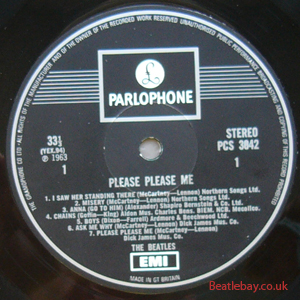
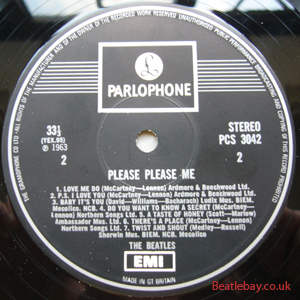
The difference between type 1a & 1b is the lining up of the 33 1/3, YEX.94/5 and the (p)1963. This is repeated on the 2 box equivalent of this exact type 1 label. There are plenty of crossovers /mismatches of type 1a & 1b
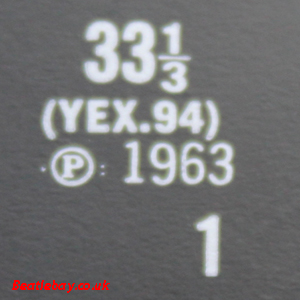
9th Press - type 2a (i+ii).
An unusual quick run on this label sees both sides using the exact same typeset as the 8th type 1 above. This label has the lines more spaced out from each other.
The problem was that the side 1 label & the side 2 label were never seen on the same record! Mother Stampers are 2MP / 1MG for this record with the side 2 bearing a side 2 9th Type 3 label.

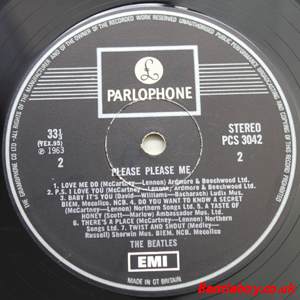
Again, because of the stamper codes, this is placed here as type
2.
There are a few mis-matched
labelled 9th presses out there,
more so
than any other type or
press of label, so it's not
uncommon to find
one with a type 2
side 1 and a
type 4 side 2 label shown to
the right here (2MH/1MG).
Currently on the hunt for a straight non crossover copy of this but I don't think one exists as the stamper numbers for the side 2 side were later than the side 1 label.

9th Press - type 2b (i+ii).
This edition belongs here only because the side 2 label should have been the match for the side 1 label above but was mismatched but is easier to show nearly side by side.
Type 4 Label for the side 1 shown here and is one of 2 different labels the side 2 label came with the other being type 5 shown to the right.


The side 2 label typeset here also exactly matches the 8th type 1 above.
2 OO / 1 OG were the earliest stampers I've found so far for this run and on further thought could have been running along side the side 1 on a different pressing machine and the engineer got the different types of label mixed when loading the machines hence the mix matches of the type 2 side 1 label with the type 5 shown here.

9th Press - type 3.
This version of this label crucially has a blank line between "7.Please Please Me", and "Dick James Mus.Co" on side 1 which sets this type (along with type 5), apart from the rest.
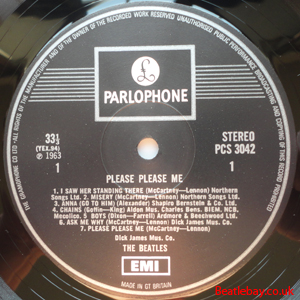
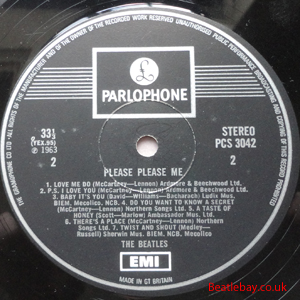
With the mother stampers at 2 MP / 1MG, this has now moved
from type 2 to type 3 in this
series. Quite a hard one to find
this.
9th Press - type 4.
This is the most common of the 6 labels and has undergone a slight shuffle of the typeset from type 3 on side 1, and the blank line has now gone.
The side 2 track layout has also been slightly reshuffled and this typeset continues throughout the 70's.
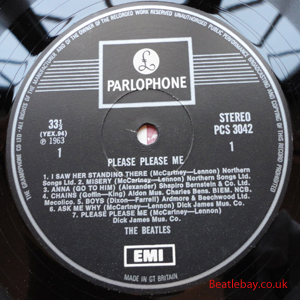
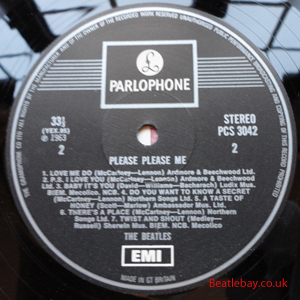
This, with the other 5 "One Box EMI" labels are considered by collectors as the very last press of the original 60's Stereos.
These pressings will go up in value shortly as they used the same Mother, Stamper, Matrix and thickness of vinyl as all the 60's pressings above.
9th Press - type 5.
This is another rarity that has cropped up. Originally I had side 1 only on a mismatch (as a side 2), but have just found another with it's correct side 2 and proper matrix no. which is 2OT / 1OG so it goes here as a type 5!
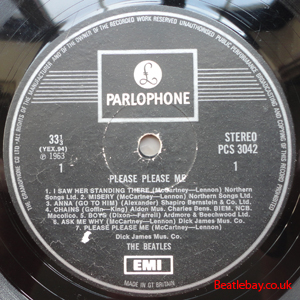
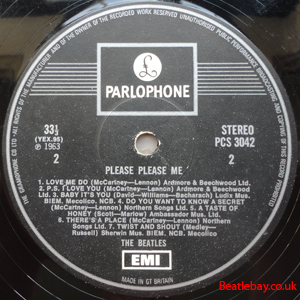
Both sides look identical to type 4 above except there is a clear blank line again on the side 1 label between 7.Please Please Me and The Beatles, like type 2 just above but does have it's differences hence it's own type designation as 5.
9th Press - type 6.
Very similar to the above label, with the major difference being the whole 4th line on side 1, being pulled to the left a bit so that the "4. Chains..." is sticking out somewhat (thou side 2 remained the same as type 5).


10th Press - type 1a.
Two Box EMI label, and pretty common as this was the first time Stereo was available as the only choice and remained so until 1982.


Same track layout as the 9th Press - type 1 (one EMI Box) label above.
The EMI box from now on was white with the EMI in black.

10th Press - type 1b.
Again just like the labels on the first 9th press there were two versions of this with the movement of the 33 1/3 the easiest way to spot them



10th Press - type 2.
Just like the 9th Press type 4 label above but with 2 EMI logo boxes.
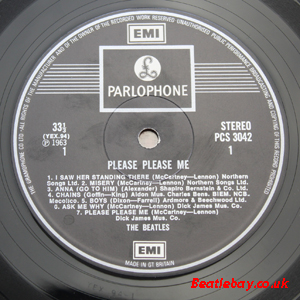
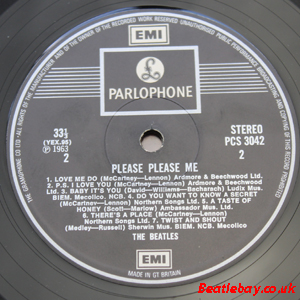
This bridges the gap slightly to the next label below.
This still has the words "STEREO" and "PCS 3042" on top of one another which has been the norm throughout the 9th and 10th presses up till this point.
10th Press - type 3a.
Another 2 Box EMI label, dating from 1971/72.
These were the last time the YEX 94-1 / YEX 95-1 matrices were used and had been all the way from 1963, and this also saw the last of the "Made In GT Britain" wording at the bottom of the labels too.
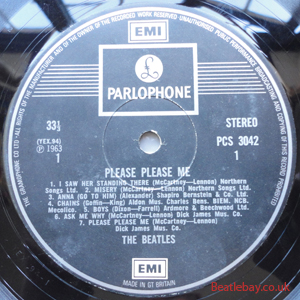
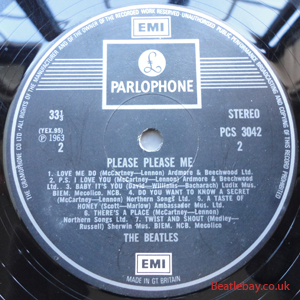
This mostly came in the two flipback (rather than 3) Cover , with a Blank to the top of the front where it usually says STEREO, made by Garrod & Lofthouse.
Matrix mother stampers for this were typically 2LP/1LA (2--/1--)
10th Press Type 3b.
Nearly identical to type 3a above except this has a definitive ridge going around the edges of the labels on both sides.
This was actually pressed on a different machine denoted by mother stampers 2TM/2LG (2--/2--)
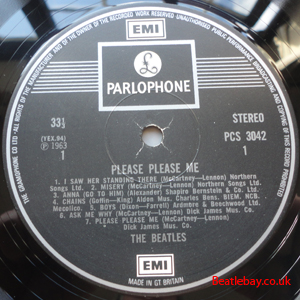
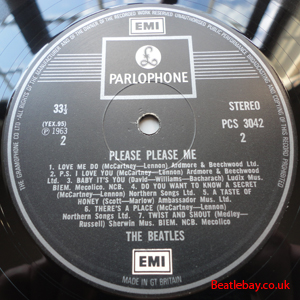
As yet to see any other difference between the two, so really only for completionist to track down..
though this interestingly has grey writing on side 1 and white writing on side 2!
Eyes out for one with both grey writing and a straight copy of white writing..
10th Press Type 3c.
This has a centre ring which may or may not been cause by the pressing machine though unlikely in this case as it has a feelable ring on both sides.

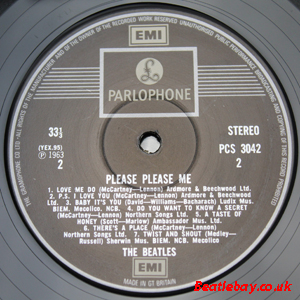
This has no outer rim like type 3b just above.
And again this interestingly has grey writing on side 1 and white writing on side 2!!
10th Press Type 3d.
This has the centre as above but this time it has the new correct white printing ink on both sides.
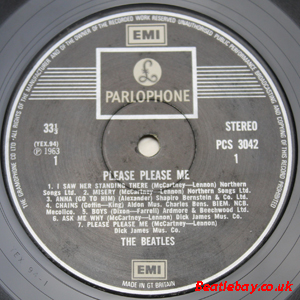
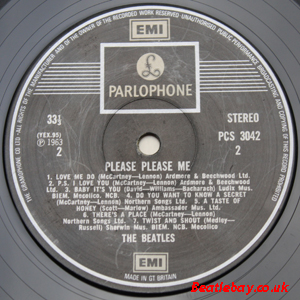
10th Press Type 4.
A very very rare one indeed.
Still using the YEX 94-1 / YEX 95-1 matrix lacquer.
This edition has no Stamper numbers at the 3 O'clock mark. The Mother numbers stamped at the 9 O'clock position are 3 / 2.
Some say this might have come from Ireland or Northern Ireland perhaps to get round the 1973-74 oil embargo as the next lot were pressed in France and Imported during this period. The paper inner sleeves were blank white with no other marks and the outer sleeves were the UK ones without the word "Stereo" to the top right front cover.
This then was the last label to have the "Made in GT Britain" writing down at the bottom.
Very Strange and unusual label!!
10th Press Type 5. (IRL)
This was the only official Irish pressing and possibly pressed in Ireland itself.. anyone?
As can be seen, a completely different font and slightly different text setup which messes with the spacing especially on the side 1 label.


Again this has no stamper numbers and this time no mother numbers either only IRL on the deadwax as well as the YEX 94-2 / YEX 95-3 matrix numbers.
Again another difficult one to track down.

11th Press. Released in 1973, the vinyl itself was pressed very briefly in France (possibly due to an Oil embargo),then imported and matched to the sleeves still being made by Garrod. Certainly by now Vinyl was much thinner which meant sound quality went out the window. This release is included in the latest Rare Record Price Guide which is the Bible for all budding Vinyl collectors so is included here.
The Stampers & numbers on the dead wax shows EMI possibly sent a set of 2nd Mother YEX94-1 & YEX95-1 lacquer plates to France for this who have also incorporated their numbering system to it on the run off: Side 1: PCS 3042 A / M6298109 1 with a 2 "mother" at 9 O'clock
Side 2: PCS 3042 B / M6298110 1 also with a 2 "mother" at the 9 O'clock mark.
12th Press - Type 1.
When vinyl pressing in the UK recommenced, they used the same Track listing layout as last used (type 10) but updated the wording around the edge of the label to include the "Made in Grt Britain" which was tagged on to the end of the line like the French had done previously.
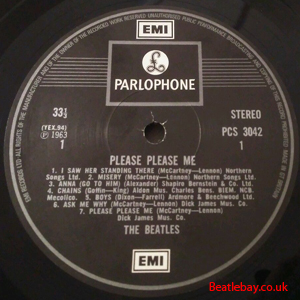
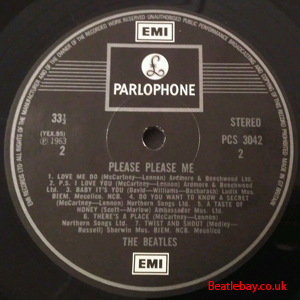
Released late 1973 or possibly 1974, this label remained for the rest of the 70's.
Matrices for this release started with the new YEX94-2 matrix on side 1, with the YEX95-1 matrix from the 10th presses above for a quick run (-2/-1), then was most commonly pressed with -2/-2 matrices, then with-2/-3.
There is even a short
lived YEX 94-3 /YEX 95-3 run
with this
particular
label!.
12th Press - Type 2.
The same layout as type 1 above but this was pressed slightly later with "Bright white ink" rather than the "grey ink" writing for the main song and writing credits.
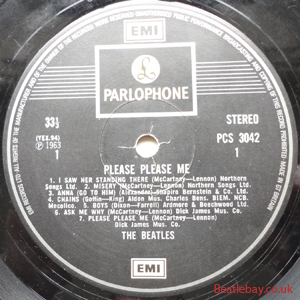
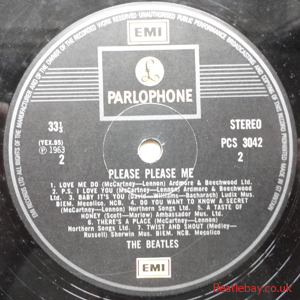
This had the matrix combination as side one now YEX 94-2, with side two being YEX 94-3.
12th Press - Type 3a.
The next update came in 1979 where the rim text was altered so that it started with 'All rights of the producer etc", and also read "Unauthorised public performance broadcasting copying and hiring etc".


This was a pressed using new lacquers as came with matrices YEX 94-4/ YEX 95-4 but has been seen with YEX94-2/ YEX95-4 matrices for a quick run.
In General, all vinyl produced by EMI at this time was much thinner(to cut costs), thus the quality of the sound wasn't as good as the original 60's pressings.
12th Press - Type 3b.
Using the same YEX 94-4/ YEX 95-4 matrices, this version has an Inner ring that can be seen and felt on side 1.


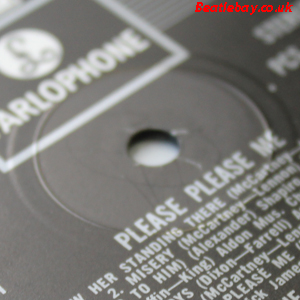
12th Press - Type 4.
Released along side the MONO boxset in 1982, was this Stereo label equivalent which basically updated the wording along the rim to: "Unauthorised copying, hiring, renting, public performance and broadcasting etc".
matrices of YEX 94-4/ YEX 95-4 remained the same.


12th Press - Type 5.
One that has just come to light and was for a long time only found on the cross over below.
Still using the YEX 94-4 & YEX 95-4 matrix.



13th Press - Type 1a(i+ii).
This is a cross over of the new type set label below and the label above with the missing dot after MUS.
I will look to see if there are any more differences between type 1 & 2 very shortly..

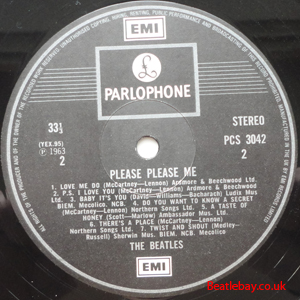
This was important to show the missing Dot was pressed like this rather than just worn out.
I have both A and B side cross overs of these labels and the matrices are 94-4/95-4 with a 4 at the 9 O'clock mark on both sides.
Interestingly the label below has matrices 94-4/95-4 but with a 5/5 which would be the final run of the original mix directly taken from the 1963 Mother.
13th Press - Type 1b(i).
This was released in late 87 and came in the later blue boxset "The Beatles Collection - BC13".
The White EMI Inner sleeve has the date 11/87 along with the 1125555 British Pat.No.
The rest of the boxset has dates ranging from 1/87(Rub),5/87(AB Rd) with Pepper being 6/87..
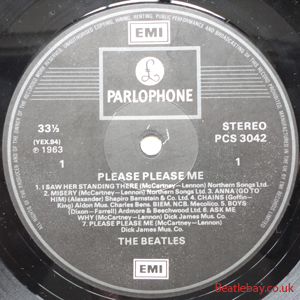
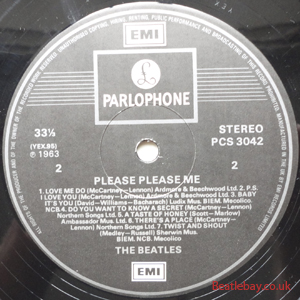
After this LP was eventually sold out and then deleted, Mono was deemed the correct mix for the first 4 beatle albums and were released that way only on CD, Tape and mono LP for the next decade or so.
The next time the Stereo version of this LP was available in the shops wasn't until 2012, and that was a new remastered mix.
13th Press - Type 1b(ii).
An oddity in that this edition still bearing the last run of YEX94-4 / YEX 95-4 with the 5/5 at the 9 O'clock mark came with this mistake of a label.
Worthy of note is that it does indeed say YEX94/95 on the label but this was a common printing error for this particular mono release (12th Pressing).
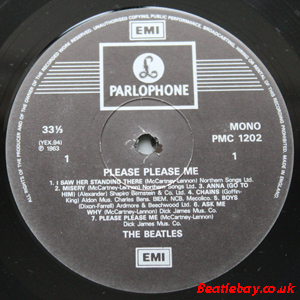
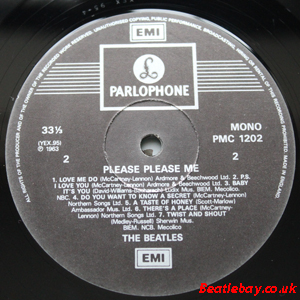
This came with both Stereo and Mono sleeves so perhaps EMI were trying to get shot of all the stereo vinyls but only had the new mono labels in stock!
This may actually be the key as to why this mono edition had the YEX matrices shown on the labels?!!?
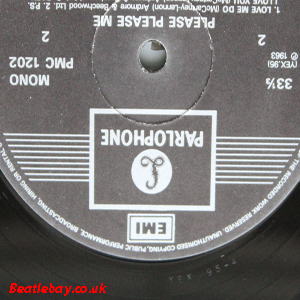
14th Press.
Released in late 2012, these labels were specially commissioned to replicate the very first Gold label at the top of this page.
These were part of the Remastered Box set that was to commemorate the 50 year Anniversary from 1962.
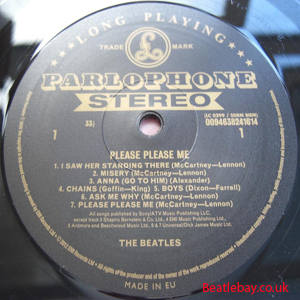
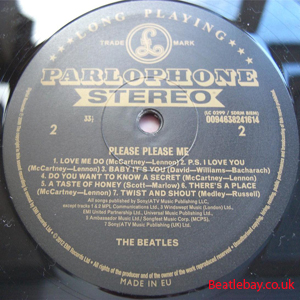
It says on the cover that remastering was done in 2009..
Nice try, but the "Made in the EU" about says it all, though soon to be a certain collectors item as the next lot should hopefully say Made in Grt Britain again!.
15th Press.
This was released in 2017 as part of the DeAGOSTINI "The Beatles Vinyl Collection".
Please Please Me Lp was number 17 in the series of 23, and came sealed with a booklet both attached to a A3 card and was found in magazine stands in such places as Tesco and WHSmith with a new LP every two weeks!
You could also have this sent out to you on mail order over the course of a year.
The sound again was a direct copy of the Digital remaster originally done in 2009.
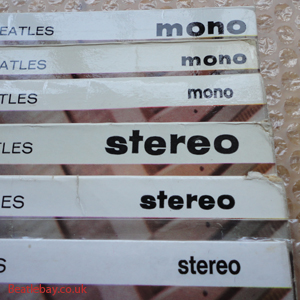
I also have used a few transitional copies I have collected. These have the end of run label on one side, & the next new label on the other. These are very helpful in determining the order of some labels plus the last & first mother stampers used for each run.. (but that's another story :)

Fake / Re-Issue. These are often passed off for the Original 1st Press Golds.
Made in the EU, probably Germany in 2010. These labels mimic the original Gold Labels and sometimes come in different coloured vinyl. Easy to spot if you know what to look for. As can be seen, there is PCS 3042A / B scratched on both sides with NO 1G / 1R stampers!! (or YEX94-1). These labels are very smooth and the STEREO banner looks too thin.
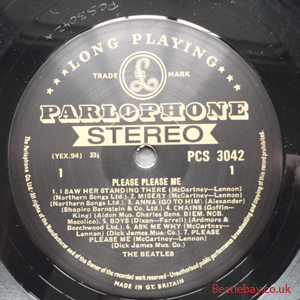
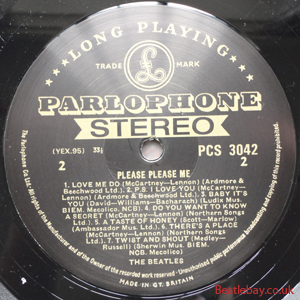
I do have to thank Beatles collecting.co.uk for originally respurring my interest (thus costing me lots of money!!), also Finn and DF have since helped me kept this passion alive. Thanks guys.
There are as always a few Labels I need to update which will happen shortly, though if you have any Labels or Pressings not shown here, (or on the Mono Page), or any mismatched labels of any Beatles record - Please Please contact me.
" All of the content featured or displayed on this web site, including, but not limited to, text, graphics, photographs images ("content") are my property.
I happily give consent for anyone to make references to it with a name check. If you would like to use any content, just ask, I'll always say Yes :) "